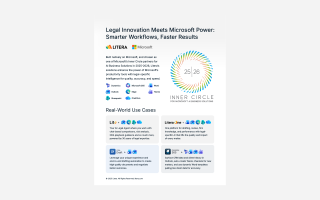A World Without Ratings: The Future of Performance Management
Even before COVID-19, the perfect performance review process did not exist. After decades of research and real-world implementations, the rapidly evolving workforce continues to lead us back to the question of how to engineer the perfect performance management process. To rate or not to rate?
Litera offers a more straightforward approach to this complex question.
Human Resource departments have been rethinking performance management for a while. Over the years, organizations have gone back and forth between the importance of employee development versus employee performance.
Many firms have changed their traditional performance review practices in favor of continuous feedback, with the effectiveness of traditional rating systems being challenged. In 2016, Goldman Sachs removed numerical ratings from their performance reviews, while General Electric dropped its annual performance rating system altogether.
Their goal - removing numerical ratings would allow them to shift focus to the future growth and development of their employees rather than solely hold them accountable for past performance – traditional performance management was evolving.
How COVID-19 Disrupted Performance Management
However, the world was not ready for the disruption that came with COVID-19. With a large percentage of the workforce going remote overnight, HR professionals scrambled to work out the logistics of performance reviews in a socially distanced world. Physical signoffs and face-to-face meetings became logistical impossibilities.
The legal and accounting worlds faced unique challenges, with technology gaps and cost-cutting measures being top priorities. The future of performance management was here right now, and the value of ratings in a radically changed world was again at the forefront of the discussion.
Some companies responded to the pandemic by canceling parts of their review cycle for the year. In contrast, others made slight alterations to their process to move toward a management style popularly referred to as “empathetic leadership.” Notably, Facebook gave all employees the same “exceeds expectations” rating for the first two quarters of 2020.
While the pandemic has brought about an abrupt change to traditional performance reviews, the need for this change and a reevaluation of ratings has been on the table for the last several years as the workforce has evolved to prioritize employee development over accountability.
The Two Sides of Numerical Ratings
Research is divided on whether removing ratings from reviews improves employee engagement and fosters more opportunities for learning and development. Critics warn of the adverse effects of anonymous feedback too easily shared. Advocates argue employee performance drops when ratings are removed.
Removing ratings altogether might be more aspirational than practical, it seems.
In the Wall Street Journal’s Talent Matters column, the authors of “The Case for Keeping Performance Review Ratings” advocate that rating systems need to remain part of the review process because they are necessary drivers for performance and growth.
They make valuable recommendations for improving the performance management process (providing ongoing feedback and making performance reviews forward-looking). They ultimately agree significant changes are needed to mend the gaps in traditional performance review methods.
The Future of Work: Hybrid Evaluation Systems
There is no perfect universal approach, as solutions will vary based on organizational culture and industry. In legal and accounting firms, there’s a greater need to keep employees accountable and more incentives to reward top performers, so ratings can assist in simplifying the review process. However, the consensus seems to lean toward adopting a hybrid evaluation system that incorporates score-based and subjective ratings.
Many firms have employed a hybrid evaluation system, as the authors of a Harvard Business Review article titled “The Performance Management Revolution” detail. They cite Deloitte’s “performance snapshots” and PWC’s scores based on five competencies as examples of a progressive compromise toward a more balanced performance review method.
Ultimately, even if they incorporate score-based ratings, performance reviews can and should be forward-focused rather than exclusively grading employees on past performance. To set a precedent on how goals are achieved, establish law firm KPIs that your employees can benchmark performance on. Conversations about performance management are most effective when they are comprehensive and consider an employee's goals and development.
As a result, the best solution to keep employee engagement high and organizational goals aligned is taking a flexible approach to your firm’s performance management practices.
“... the concepts of ratings themselves are not the issue. Organizations need to make decisions about people: who will get promoted; who will get more money; who will take the new assignment; who is holding the team back. And these decisions themselves are essentially evaluative by nature.” - Josh Bersin
The Key to Effective Performance Management Moving Forward Is Agility
In a post-COVID-19 world, the appraisal process is more people-centric than ever as organizations strive to keep a pulse on how their people have been affected by the pandemic as additional context for their performance reviews. However, the ultimate goal of the process as a whole is still the same: keep top talent engaged and communicate and integrate the organization’s goals to direct employee development.
Whether your firm chooses to keep numerical ratings, transition to a more subjective ratings scale, or throw out the ratings system altogether, the key is to be agile, focus on people, and use flexible methods that evolve with your organization’s talent management needs.
Learn about Top Performance - Micron Systems' Performance Management Software.




